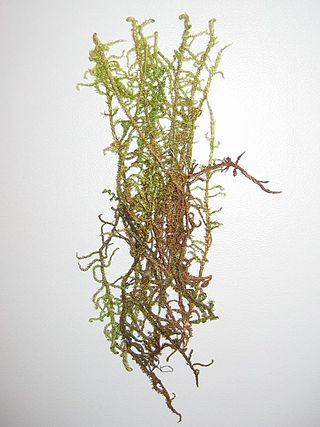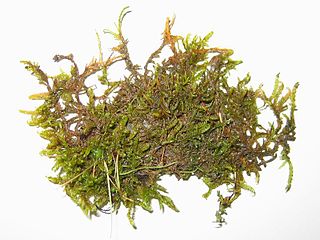
Hedenham is a civil parish in the English county of Norfolk. It covers an area of 7.30 km2 (2.82 sq mi) and had a population of 173 in 70 households at the 2001 census, including Thwaite St. Mary and increasing to 240 at the 2011 Census. For the purposes of local government, it falls within the district of South Norfolk.

Hamatocaulis vernicosus, the varnished hook-moss, is a species of moss belonging to the family Amblystegiaceae.

Pseudocalliergon lycopodioides is a species of moss belonging to the family Amblystegiaceae.
Pseudocalliergon is a genus of mosses belonging to the family Amblystegiaceae.

Talsi rolling hills is a nature park in the middle of Talsi Municipality. It is located in the north-western part of Vanemas pauguraine and includes the highest part, administratively belongs to Laidzes, Laucienes and Lībagu parishes. The protected area was established in 1987 to protect one of the North Kurzeme Uplands and highest part of the Elder Hill. It is most diverse areas in terms of natural conditions in the Latvia north-east, with a distinctly hilly terrain and several small but deep lakes. Scenic area. Natura 2000 territory. Many Latvia rare and protected plant and animal species. In total 24 species of flora (1) and fauna (23) are protected under EU Nature directives.
Campylium is a genus of mosses belonging to the family Amblystegiaceae.

Homalothecium is a genus of mosses belonging to the family Brachytheciaceae.
Sanionia is a genus of mosses belonging to the family Amblystegiaceae.
Scorpidium is a genus of mosses belonging to the family Amblystegiaceae.
Straminergon is a genus of mosses belonging to the family Amblystegiaceae.
Pseudoamblystegium is a genus of mosses belonging to the family Amblystegiaceae.
Sarmentypnum is a genus of mosses belonging to the family Calliergonaceae.
Pseudocampylium is a genus of mosses belonging to the family Amblystegiaceae.
Platydictya is a genus of mosses belonging to the family Amblystegiaceae.

Drepanocladus is a genus of mosses belonging to the family Amblystegiaceae. It has a cosmopolitan distribution

Scleropodium is a genus of mosses belonging to the family Brachytheciaceae. The genus has an almost cosmopolitan distribution.
Pelekium is a genus of mosses belonging to the family Thuidiaceae.
Isopterygiopsis is a genus of mosses belonging to the family Plagiotheciaceae.

Sciurohypnum, or Sciuro-hypnum, is a genus of mosses belonging to the family Brachytheciaceae.
Cyrto-hypnum is a genus of mosses belonging to the family Thuidiaceae.







